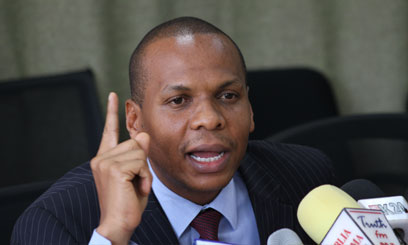
Mungatana said they would like to have the parameter based on population size reduced to 25 percent/FILE
NAIROBI, Kenya Apr 27 – Four lawmakers from Tana River, Marsabit and Garissa say they will move amendments to re-define parameters used by the Commission on Revenue Allocation (CRA) to determine funding for counties when the proposals are debated in Parliament.
Addressing a news conference at Parliament Buildings, MPs Danson Mungatana, Adan Duale, Chachu Ganya and Abdul Bahari opposed the formula used, saying it was meant to increasingly marginalise their regions.
Mungatana said they would like to have the parameter based on population size reduced to 25 percent (from 60pc), and an increase in the equal share (pegged at 20pc) and poverty level parameters (12pc) as in the case in Nigeria, India and Indonesia.
“It is these equal shares in marginalised counties that form the main amount of money that we expect to get from this formula the CRA has proposed. Why can’t you remove some percentage from population and move it to equal share and poverty index; these are the questions that we must grapple with,” said the Garsen MP.
Isiolo South’s Bahari claimed that the Commission might have been intimidated into adopting the formula, which he said will create disparity.
“To me this looks like a commission that is intimidated… it cannot act,” Bahari said adding “In the spirit and letter of devolution is supposed to initially protect the interest of the underdeveloped.”
CRA chairman Micah Cheserem said the money will be allocated to the 47 counties based on a population at 60 percent, poverty levels at 12 percent, size at six percent, and fiscal responsibility pegged at two percent. The remaining 20 percent will be shared equally among the 47 counties.
For the funds to be channelled to the counties, Parliament will have to pass two Bills, the Division of Revenue Bill and the County Allocation of Revenue Bill, at least two months before the end of every financial year.
Duale said the formula works against the principle of devolution while his North Horr counterpart Chachu Ganya said that he would move to court to block the implementation of the formula in case they are unsuccessful in amending in Parliament.
“The fundamental reason why this country went for a new Constitution was to give the people there equitable right shares in terms of resources and governance in this country,” the Dujis MP added.
Ganya said the Commission had done a ‘shoddy job’ and had failed to justify the ‘high salaries’ by presenting a formula that could not meet international standards.
” We will fight on the floor of the House but if need be we will do what we have to do and that means going to the courts of law to fight it out,” he said.
The Commission on Revenue Allocation (CRA) on Thursday recommended that county governments should receive an allocation Sh203 billion and Sh407 billion going to the national government.
The commission’s proposal for county governments is more than the Sh160 billion approved by the Cabinet last week for the next financial year.
Speaking during the launch of the share formula between the national government and the 47 counties, Commission chairman Micah Cheserem said they were working with 2011/12 audited revenue but they expected the government to collect revenue of Sh800 billion in 2012/13.
He invited public discourse over the formula before it is forwarded to Parliament for debate and approval adding that it will be in place effectively for four months in the event of a March poll.
“If elections are held on March 4, 2013, the earliest the government will be in place will be in April next year. In all likelihood, the 2012-2013 Budget will be run by the national government to the tail-end,” he said.
According to the formula, 60 percent of the allocation will based on population size, 20 percent on basic equal share, 12 percent on poverty level rate, 6 percent on the size of land and 2 percent on fiscal responsibility exercised by the county. The remaining 20 per cent will be shared equally among the 47 counties.
Director for Research Moses Sichei explained that the formula which can be amended after three years is aimed at ensuring equity in resource distribution and sealing the disparities witnessed in allocations.
Top beneficiaries in the allocations include Nairobi Sh11.7 billion, Nakuru Sh6.9billion, Kiambu Sh6.5 billion, Kakamega Sh7.3 billion, Bungoma Sh7.2 billion, Turkana Sh5.7 billion, Kisii Sh5.5 billion, Kisumu Sh4.6 billion, Kilifi and Kisii Sh5.5 billion each, Wajir Sh4.7 billion and Uasin Gishu Sh4.3 billion.
Lamu, which is the smallest of the 47 counties in the country, will receive Sh1.4 billion.
At the tail-end of the disbursements are Isiolo Sh1.9 billion, Samburu Sh2.2 billion, Taita Taveta and Tharaka Nithi Sh2.3 billion each while Elgeyo Marakwet was allocated Sh2.4 billion, Laikipia and Tana River Sh2.6 billion each.
Parliament will have to approve two funding Bills, the Division of Revenue Bill which deals with sharing of revenues between the national and county governments and the County Allocation of Revenue Bill which relates to the sharing of revenue among the counties, at least two months before the end of each financial year.
The commission’s technical committee is still working on the criteria on distribution of the equalization funds, but Commissioner Raphael Munavu urged that the county government must be allowed to prioritize their own development projects with special preference to water, education and health services.
The commission recommended that the Equalisation Fund (0.5 per cent of the national Budget) be disbursed from the 2013-2014 financial year when county governments will be functioning.
It also proposed that the funds set aside for the 2011-2012 and 2012-2013 financial years be rolled over to the 2013-2014 financial year.
The sectors to be targeted for improvement are water, education, health services, energy and rural access roads.










































